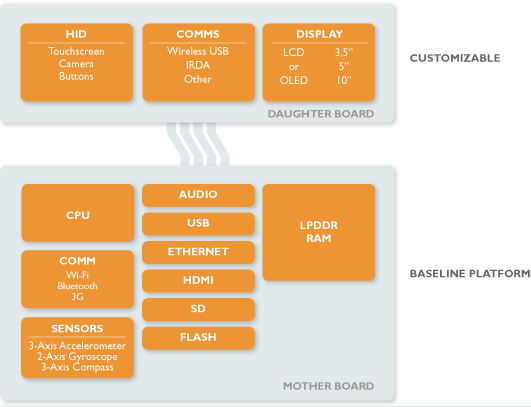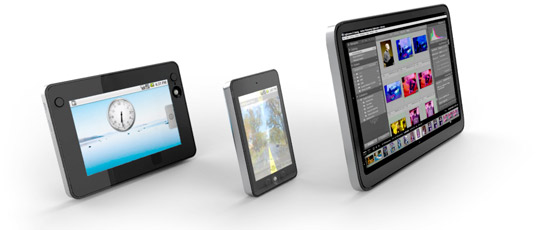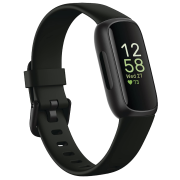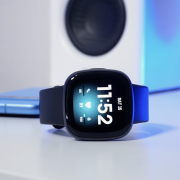![]() Not to be confused with Motorola, the MOTO Development Group today announced that they’ll be launching their Android Media Platform, a mobile device cookie cutter for Android 2.0. With AMP, hardware manufacturers will be able to work closely with MOTO in prototyping, designing, and testing their latest devices, providing an infrastructure to ensure the most rapid development cycle possible.
Not to be confused with Motorola, the MOTO Development Group today announced that they’ll be launching their Android Media Platform, a mobile device cookie cutter for Android 2.0. With AMP, hardware manufacturers will be able to work closely with MOTO in prototyping, designing, and testing their latest devices, providing an infrastructure to ensure the most rapid development cycle possible.
It’s quite difficult to explain exactly what AMP is, but the best way I can go about it is to say that the underlying hardware consists of a TI OMAP-based chipset, acting as a snowball that brings together support for many different types of hardware components that would be essential to just about any mobile device out there (including mobile phones, MIDs, tablets, and more). This means that any manufacturer looking to create an Android-based device of any sort can deal without the headaches of initial product design and prototyping by employing MOTO to help them piece together exactly the type of hardware that they envision, using only one device platform for the entire process.

Looking at the flowmap above, you can see how the platform’s motherboard is fragmented to support ease-of-use in plugging in many different types of components which would soften the testing and implementation cycle for the manufacturer. Essentially, MOTO and Texas Instruments wants everyone to believe that a 4-month development cycle, from conception to a finished product, is feasible (and why not? Surely this style of rapid delivery has progressed other technologies through extensive research).
Eli Belmond of Texas Instruments shares similar sentiments with the CEO of MOTO:
“Texas Instruments is pleased to collaborate with MOTO on the development of the Android Media Platform (AMP). Working together, MOTO completed the AMP reference design in four months including hardware design, software port and platform development. With this short development time, MOTO is able to interest customers who are looking to innovate on the Android platform today.”
MOTO provides 3 different base hardware specifications for AMP: 5″, 3.5″, and 10″ specifications are the three starting points for any given manufacturer to begin with. Currently, only the 5″ is available for development, but the other two are expected to be available starting in early 2010. You can head over to MOTO’s site to see a full breakdown of the type of hardware and software support that each specification provides.

“MOTO’s AMP platform highlights the capabilities and performance of the OMAP3430 processor while providing the tools to allow OEMS to quickly create differentiated Android devices in a range of specifications. Further, MOTO has a roadmap in place to continue to leverage OMAP technology to remain at the forefront of innovation. We believe solutions like AMP will be crucial to driving innovation in the Android market and supporting growth of this thriving operating system.”
It seems as if Texas Instruments has another motive in all of this: they want to springboard their processor architecture to be the defacto for Android devices going forward, knocking off Qualcomm as the #1 chipset manufacturer for current Android technology. Just to put things in perspective for comparison purposes, the OMAP3430 is the same processor which powers the Palm Pre.
I know some of you are probably scratching your heads right now in trying to figure out what this means for you (I know I was). It means more Android devices, whether it be a phone, a tablet, or what have you, at a faster rate and with a lot more options. With MOTO making it this easy for hardware manufacturers to grasp the Android platform, I can only drool at the thought of the sheer amount of devices we could be in for. Perhaps this can be another way out for companies like Dell, who’ve struggled up to this point with providing an Android phone worth buying, or an easier way for companies like Creative or Sandisk to provide fresh media player products to help combat Microsoft and Apple with their dominance in those markets.
We contacted MOTO regarding this to see if there were any manufacturers already working with them using AMP, but they were unable to provide any information regarding that at this time. If any more comes from it, we’ll be sure to fill you in.
Here’s a question for you readers: what types of devices would you like to see come to fruition thanks to MOTO’s accelerated platform development solution? What companies do you think would benefit most from this, and for what reason/function? Sound off in the comments below!
[Thanks Carl!]










Could they possibly have chosen a more confusing name?
I wonder how Motorola feels about MOTO Amp
I am really hoping someone comes out with a internet tablet soon. I like the idea of something like the crunchpad running Android. Cant wait!
Ryan, Archos is coming out with the Archos 5 tablet, which features Android. You can find it on display at some Best Buys if you have one near you.
Hmm, not only is Android taking on the iPhone. It’s taking on the whole iPod franchise as well!
that 10 incher isn’t android .. its running lightroom as far as i can see
but im not going against it!
@ Brad, correct.
If what this article is talking about becomes true, it will enable players to assemble new devices super quick. Assuming this makes devices cheaper (as they run android as well) you can pretty much say good bye to the old school players. Bare in mind, Texas makes the super smooth DAC that the later gen Ipods and many other warm sounding media players use.
edmund, it’s true that the 10 incher may not be running Android, as the specifications say that Android is optional as the overlay on the linux kernel.
…great…now Motorola is gonna make a new android phone and call it Amp, just to f**k with us.
@edmund and quentin: android isn’t specified for high resolution yet, so if you’d take 10 inch with a decent resolution, you wouldn’t be able to use the android app store for example.
another question: can’t see gps, but it has a compass, isn’t that strange?
Ramin: The 10″ one do has got gps. :) and fm :D and compass :DD and 8000 mah battery :DDD
I feel like a child before Christmas :D LOL
Here’s the recipe for what I, personally, would consider the pinnacle of PMP/UMPC evolution.
Take one Archos 5 Internet Tablet.
Remove:
– LCD screen
– plugin requirements
– plethora of bugs
Add:
– (MOTO AMP with Android 2.1)
– 5″ capacitive OLED touchscreen
– camera and compass to comply with Google Android Marketplace requirements
– 32GB or better SDD
– SD or microSD slot
– battery life of no less than 15h for video, 40h+ with screen off
– optional 3G support
– dedicated DSP (such as BBE used in Cowon devices)
– sell for < $500.